ChrisHepburn/iStock Unreleased via Getty Images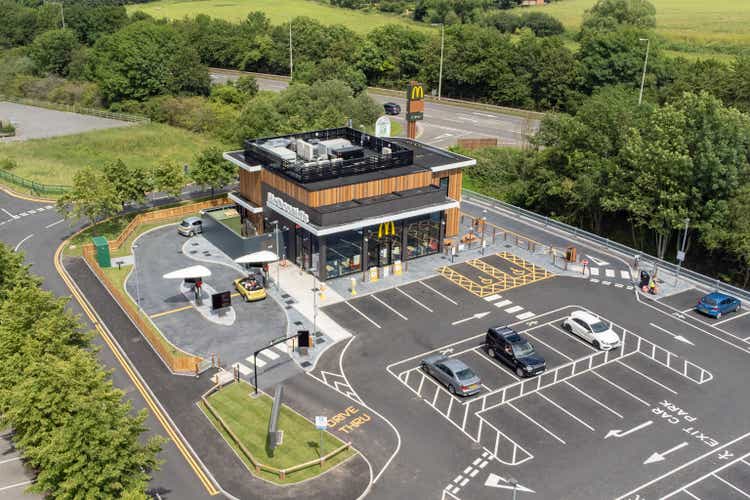
REIT Rankings: Net Lease
This is an abridged version of the full report and rankings published on Hoya Capital Income Builder Marketplace on December 14th.
Net Lease REITs – one of the more “bond-like” and rate-sensitive property sectors – have surprisingly been among the best-performing property sectors this year despite their muted property-level growth and narrowing investment spreads amid the surge in benchmark interest rates and inflation this year. Within the Hoya Capital Net Lease Index, we track the eighteen net lease REITs and one ground lease REIT, which account for roughly $110 billion in market value led by Realty Income (O), W. P. Carey (WPC), and National Retail (NNN). These net lease REITs generally own single-tenant properties leased to high credit-quality tenants under long-term leases, focused primarily on retail, restaurant, and industrial properties.
“Net lease” refers to the triple-net lease structure, whereby tenants pay all expenses related to property management: property taxes, insurance, and maintenance. One of the more “bond-like” property sectors, net lease REITs tend to operate more like a financing company than a property manager and have investment characteristics similar to corporate bonds due to the long-term nature of most net leases and the underlying “credit” exposure through their tenants’ ability to pay rent. Unlike corporate bonds, however, net lease REITs have the ability to grow distributions through a combination of organic (same-store rent increases) and accretive external growth (acquisitions).
Triple net leases – which are used to varying degrees across the REIT universe including the Casino and Healthcare REIT sectors – proved to be particularly durable throughout the pandemic-related turmoil regardless of the headwinds endured by their tenants. While nearly every property sector uses the triple-net lease structure to some degree, we focus this report primarily on the free-standing retail net lease REITs and diversified REITs which make heavy use of the net lease structure that don’t otherwise fall neatly into one of the other property sectors. Some net lease REITs focus their strategy on investment-grade tenants with near-zero credit risk, while others focus on “middle-market” or smaller tenants that have higher levels of potential credit risk.
With this bond-like lease structure, naturally, comes bond-like risks – notably a high sensitivity to inflation and interest rates. Inflation and rate sensitivity are driven by several interacting factors including lease structure and term, external growth potential, tenant credit quality, and the cyclicality of the underlying property type. Within the net lease sector, inflation risk isn’t always efficiently-priced, and currently, we see signs of complacency in REITs with higher inflation risk and undervaluation among REITs that are better-hedged if inflation does prove to be less “transitory” than expected. Only a handful of net lease REITs include explicit CPI linkages in their rent escalators – namely W. P. Carey which has a sector-high 55% of its leases calculated using a CPI-based formula. Spirit Realty (SRC), meanwhile, has been able to drive same-store rent growth through its strategy of targeting “middle-market” tenants, where we find that lease terms are generally more favorable to the landlord and performance is more economically sensitive.
Curiously, net lease REIT investors, executives, and asset owners have seemingly never bought into the idea of a “new normal” of sustained higher interest rates and have plowed ahead with their acquisition-focused growth strategies despite the significant surge in their cost of capital. Per recent earnings call commentary, net lease REITs have so far seen surprisingly modest cap rate expansion with estimates ranging from as low as 30 basis points on a year-to-date basis to a high of 150 basis points with the average around 50-60 basis points – during which time we’ve seen Investment Grade effective yields climb by 250-300 basis points. The pace of acquisition activity has slowed only modestly in recent months with several REITs actually increasing their full-year acquisitions outlook in the latest quarter – a strategy that could pay off if we do indeed see a “soft landing” and return to “lower for longer” – but could prove costly if rates remain persistently elevated.
Balance sheet quality also plays a critical role in the degree of interest rate risk – and the “cost of capital” more broadly – and the net lease REITs that have lower leverage and more long-term fixed-rate debt should be able to maintain accretive investment spreads in a variety of macroeconomic environments – assuming that acquisition cap rates also track the rise in their cost of capital. We see more potential for opportunistic acquisition activity in the middle-market cap rate tiers where these REITs can leverage their relatively strong balance sheets and access to long-term capital to be aggressive as some more highly-levered private players with shorter-term capital seek an exit with Blackstone (BX) being a notable recent example, having sold about half of BREIT’s net lease portfolio earlier this month to VICI Properties (VICI).
Net Lease REIT Earnings Results
Acquisition-fueled external growth has historically been the “bread and butter” of the net lease sector’s strategy, explaining the vast majority of the sector’s FFO (“Funds From Operations”) growth over the last two decades. As noted above, the substantial shift in the interest rate environment has raised questions about these REITs’ ability to continue to source accretive acquisition opportunities if these firms’ cost of capital remains elevated compared to acquisition cap rates. Despite the narrower investment spreads, it’s been “business as usual’ for most net lease REITs, which have acquired more assets over the last 12 months than in any period since 2013. Notably, while net lease REITs account for just 7% of the Equity REIT Index – they accounted for over a third of total REIT acquisitions over the past twelve months.
The “business as usual” strategy is working just fine, for now, but we believe that it does present additional operational and execution risks that need to be closely monitored in the quarters ahead. As discussed in our REIT Earnings Recap, recent earnings results have been quite solid across the net lease sector in recent quarters with eight of the eleven REITs that provide guidance raising their full-year FFO outlook in Q3. Accretive acquisitions helped to drive average full-year FFO growth of nearly 15% last year – bringing the sector well above its pre-pandemic level – and the outlook for 2022 was revised higher in the third quarter to 7.8%, on average, up 150 basis points from last quarter.
Upside standouts included W. P. Carey, which raised its full-year FFO outlook driven by record-high rent growth resulting from CPI adjustments. WPC now expects FFO growth of 5.0% this year – up 40 basis points from its prior outlook. National Retail was also an upside standout after it raised its full-year FFO growth outlook to 9.4% – up 120 basis points from its prior outlook. The most significant FFO boost came from Small-cap Alpine Income (PINE), which raised its full-year FFO growth target by 910 basis points to 10.1%. Assuming that the revised full-year targets are hit, the REITs that will have delivered the strongest FFO growth from the end of 2019 through 2022 include Essential Properties (EPRT), Getty Realty (GTY), and Realty Income. Notably, EPR Properties (EPR) will still be underwater by about 15% below pre-pandemic FFO levels even if it achieves its 41% forecasted FFO growth.
Perhaps even more important than the FFO guidance this quarter was the outlook for acquisitions activity and commentary around cap rate movement. Seven REITs provided specific commentary on the observed movement in cap rates on their earnings calls which ranged from a low of 30 basis points to a high of 150 basis points on a year-to-date basis. Despite this relatively muted uptick in cap rates – which come as benchmark interest rates have risen by closer to 300 basis points – only half of these REITs lowered their full-year acquisition target while two REITs – Agree Realty and National Retail – actually increased their full-year target. Notably, Spirit Realty and W. P. Carey each scaled back their pace of acquisition activity, as did Broadstone, EPR Properties, and Alpine Realty. Meanwhile, Realty Income maintained its guidance calling for “Over $6.0B” in acquisition this year which was raised in the second quarter from its prior target of $5B.
At the outset of the pandemic, investors were reminded that many net lease sectors, through their underlying tenant base, have heavy exposure to industries that bore the brunt of the “social distancing” impact of the virus outbreak including restaurants and experience-based categories such as movie theaters, fitness, and education. While the triple-net lease structure has provided a strong degree of protection for most segments, some tenants in several heavily impacted categories struggled to pay their rent early in the pandemic, but property-level fundamentals have essentially fully normalized with rent collection rates back to pre-pandemic levels across the sector.
Movie theaters remain one notable exception and area of lingering distress as Cineworld – the global No. 2 movie-theater chain and owner of Regal Cinemas – filed for bankruptcy this past quarter. Cineworld accounted for roughly 13% of EPR’s rents through the first half of 2022. A handful of other net lease REITs have between 1.5-5% of their rents coming from movie theater tenants, but these REITs have not seen any material uptick in missed rents from these theater tenants despite the apparent distress. Box Office Mojo data shows that box office revenue plunged 80% in 2020 and has remained about 35% below 2019 levels in 2021. Fueled by a strong slate of long-delayed movie releases including Top Gun – which set several new revenue records – the outlook brightened a bit in mid-summer, fueling a recovery to about 70% of pre-pandemic ticket sales, but the momentum has faded in recent months.
Net Lease REIT Stock Performance
Net lease REITs were slammed early in the pandemic – plunging more than 50% at their lows in March 2020 – but began a rebound in mid-2020 and have delivered notable outperformance over the REIT Index in recent quarters despite concerns over rising rates and inflation, a similar dynamic to outperformance that we saw in the prior rate hike cycle from 2015-2019. The Hoya Capital Net Lease Index – a market-cap weighted index of these 18 REITs – is lower by 9.5% so far in 2022, significantly outperforming the 24.6% decline from the broad-based Vanguard Real Estate ETF (VNQ) and the 15.9% decline from the S&P 500 ETF (SPY).
The counterintuitive outperformance for net lease REITs this year is consistent with the phenomenon discussed earlier this year in which net lease REITs actually outperformed the REIT sector during the prior Fed rate hike cycle from 2015-2019 after significantly underperforming in the 18-month lead-up to the first hike – a similar backdrop to the current dynamic. From Q4 2015 through Q2 2019, net lease REITs delivered total returns of nearly 80% – more than double the 35% total returns of the NAREIT All Equity REIT Index during that time. Critically, net lease valuations respond primarily to long-term interest rate and inflation expectations – not short-term rates or realized inflation.
The relatively muted performance of the market-cap-weighted net lease index over the past few years, however, does mask some of the bifurcations in the performance between sub-segments of the sector. Notably, many of the smaller-cap REITs that outperformed in 2021 have been laggards this year, characteristic of a “flight to balance sheet quality” within the sector. The best-performing net lease REITs this year include Getty Realty, W. P. Carey, and National Retail which have been among the largest holdings in our REIT Focused Income Portfolio. Laggards this year include Safehold (SAFE) the lone REIT focused specifically on ground leases – which dipped more than 60% this year – containing a stretch of underperformance since its strong gains in 2019 and 2020.
Net Lease REIT Dividend Yields
Fueled by this external growth and improved property-level performance, fourteen of the nineteen net lease REITs boosted their payouts in 2021 and we’ve seen another twelve net lease REIT dividend hikes this year, joining a total of more than 120 REITs that hiked their dividends this year. Net lease REITs were largely unfazed by the wave of dividend cuts that swept through the REIT sector in 2020, and with the wave of increases over the past 24 months, the sector is now on pace to achieve cumulative dividend growth of roughly 7% over the baseline 2019-levels.
Relatively high dividend yields are one of the key investment features of the net lease REIT sector, and the resilience in maintaining or increasing dividends has helped to push dividend yields toward the top of the REIT sector. Net lease REITs now pay an average dividend yield of 5.2%, a premium of 140 basis points over the broader market-cap-weighted REIT average of 3.8%. Net lease REITs pay out roughly 75% of their free cash flow, also towards the top end of the REIT sector average, but typically make heavy use of secondary equity offerings to raise capital to fund accretive external growth.
Within the sector, we note the dividend yields and historical dividend growth of each of the eighteen net lease REITs. Of note, a half-dozen of these REITs have delivered consistent dividend growth over the past half-decade, led by Getty Realty, Four Corners (FCPT), STORE Capital (STOR), Agree Realty, and Realty Income. Eight net lease REITs are currently paying a dividend yield above 6%, led on the upside by externally-managed Necessity Retail (RTL) and Global Net Lease (GNL) which each command a dividend yield above 10%.
Takeaway: Selectivity Becoming More Important
Overall, we remain bullish on net lease REITs, which have taken advantage of the structural competitive advantages of the public REIT model better than any other property sector in our view, utilizing the strength of their balance sheets and unique tax advantages to fuel accretive acquisition-driven growth. That said, the net lease industry simply hasn’t bought into the idea of a “new normal” of sustained higher rates as these REITs have plowed ahead with acquisitions while cap rates have been slow to reset higher to match the rise in benchmark yields. The “business as usual” strategy is working just fine, for now, but we believe that it does present additional operational and execution risks that need to be closely monitored in the quarters ahead. We see better value in REITs that focus on “middle-market” tenants where you’ll typically see more rate-hedging lease structures and initial yields that grant more breathing room for higher financing costs and the potential of persistently higher rates.
For an in-depth analysis of all real estate sectors, be sure to check out all of our quarterly reports: Apartments, Homebuilders, Manufactured Housing, Student Housing, Single-Family Rentals, Cell Towers, Casinos, Industrial, Data Center, Malls, Healthcare, Net Lease, Shopping Centers, Hotels, Billboards, Office, Farmland, Storage, Timber, Mortgage, and Cannabis.
Disclosure: Hoya Capital Real Estate advises two Exchange-Traded Funds listed on the NYSE. In addition to any long positions listed below, Hoya Capital is long all components in the Hoya Capital Housing 100 Index and in the Hoya Capital High Dividend Yield Index. Index definitions and a complete list of holdings are available on our website.


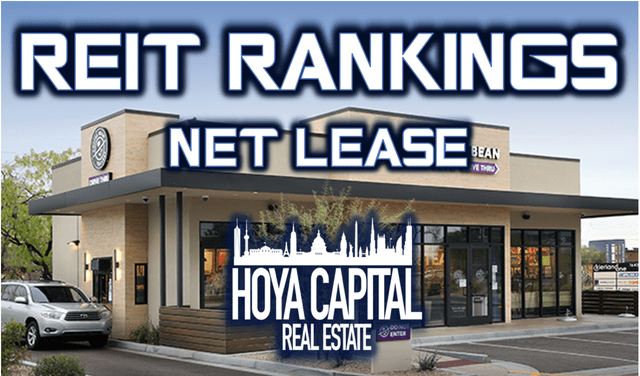
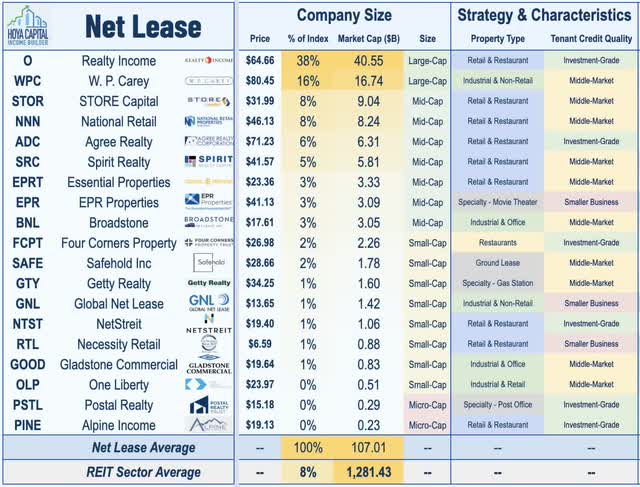
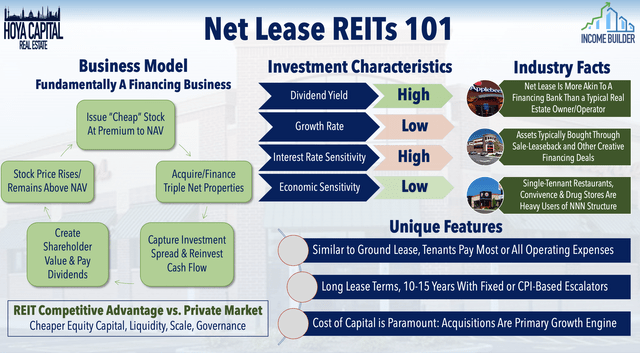
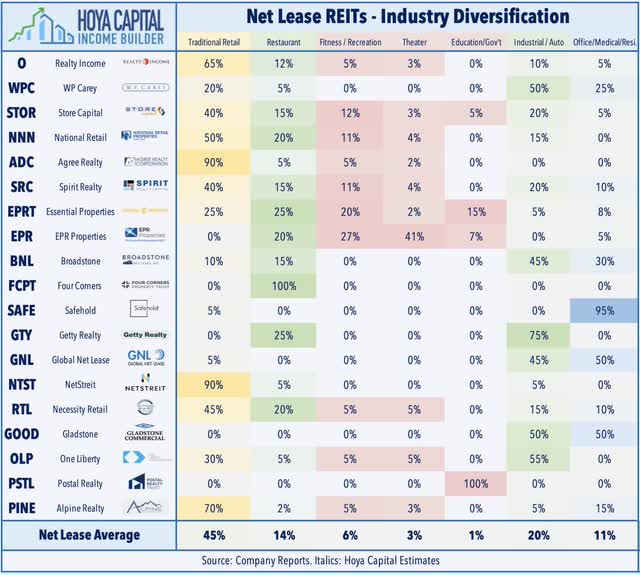
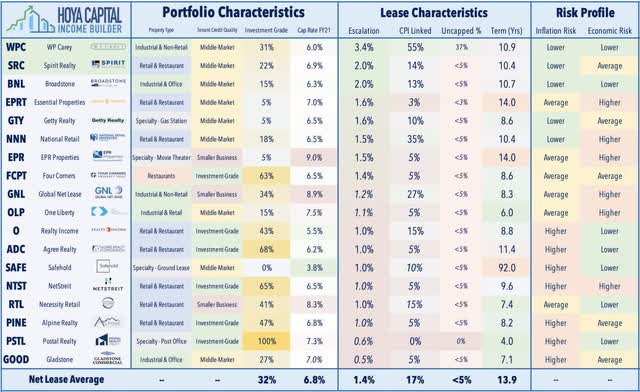
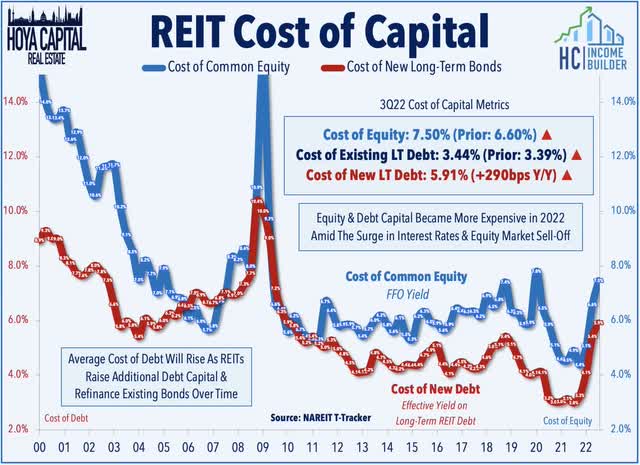
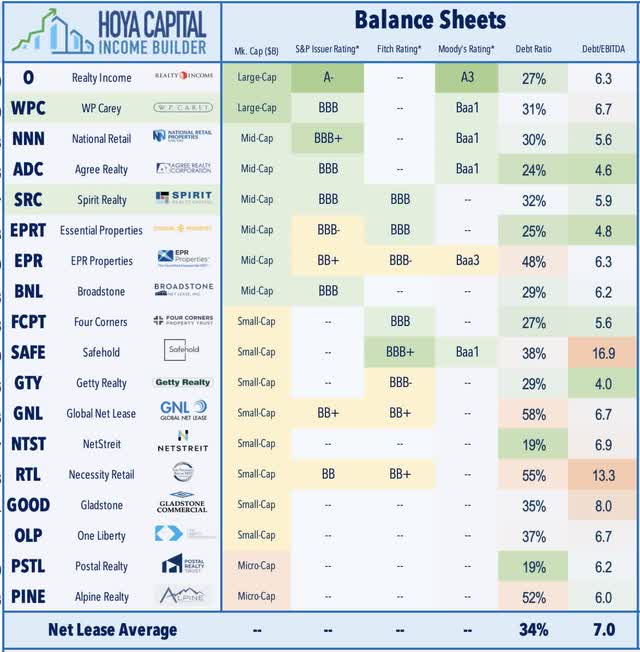
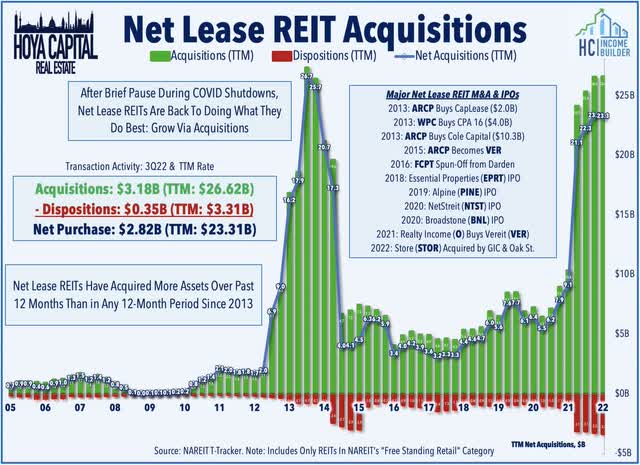
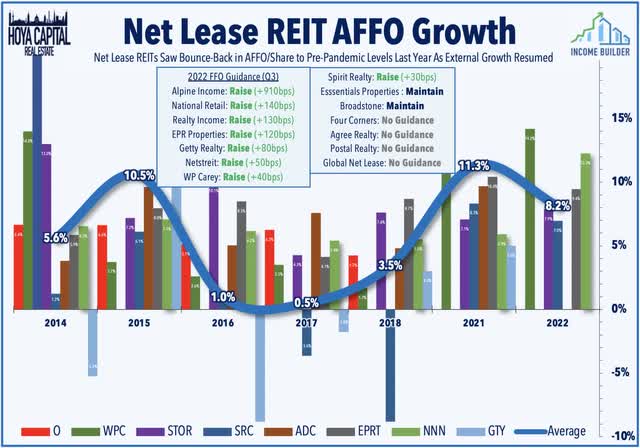
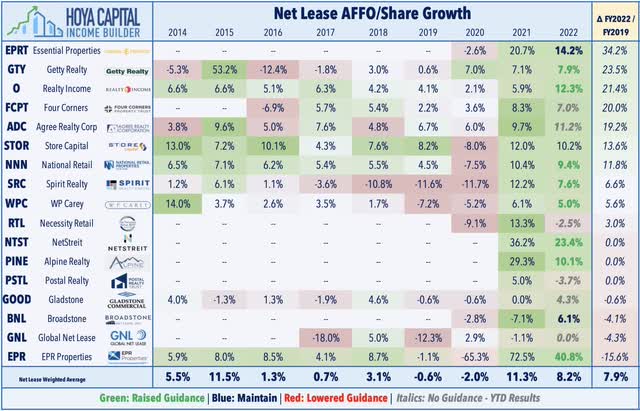
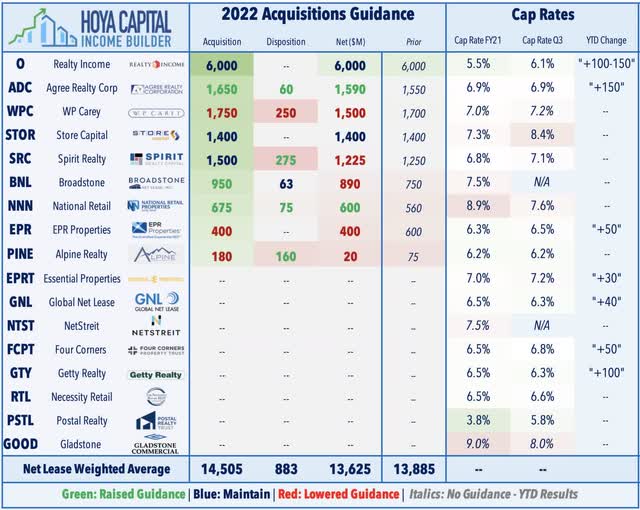
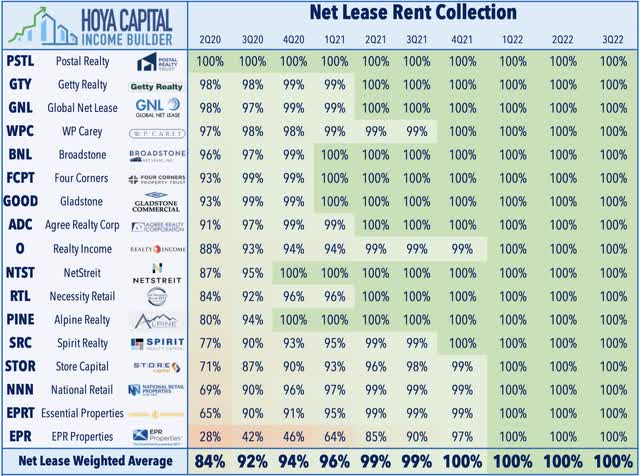
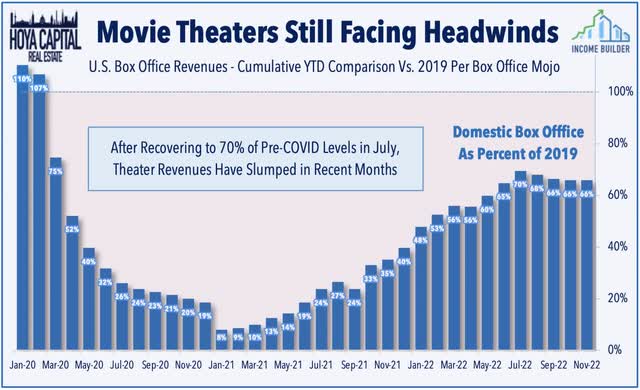
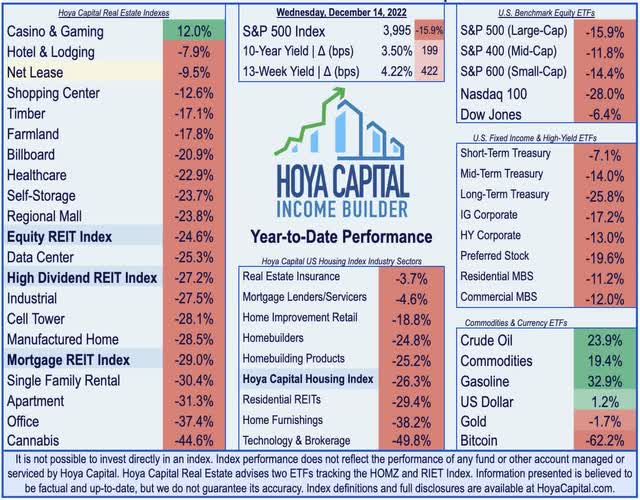
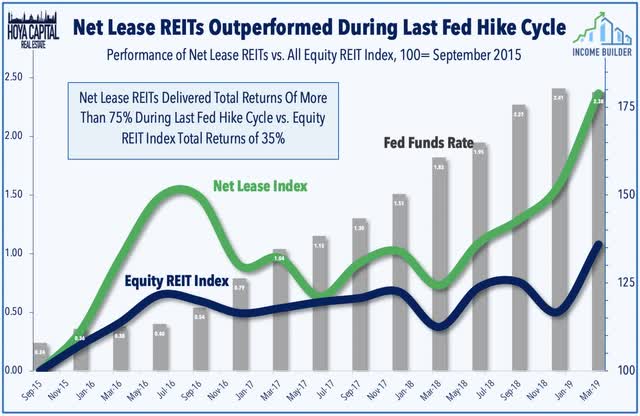
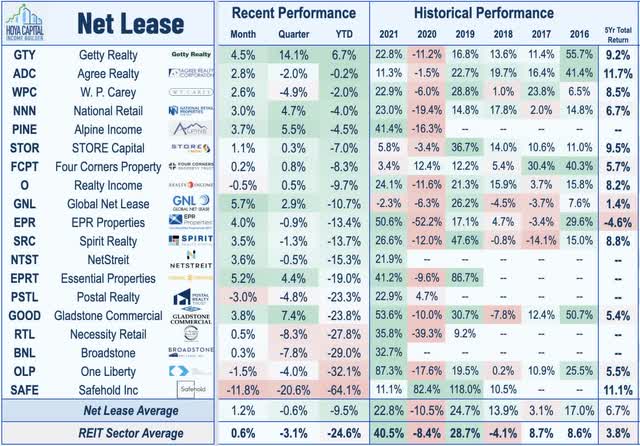
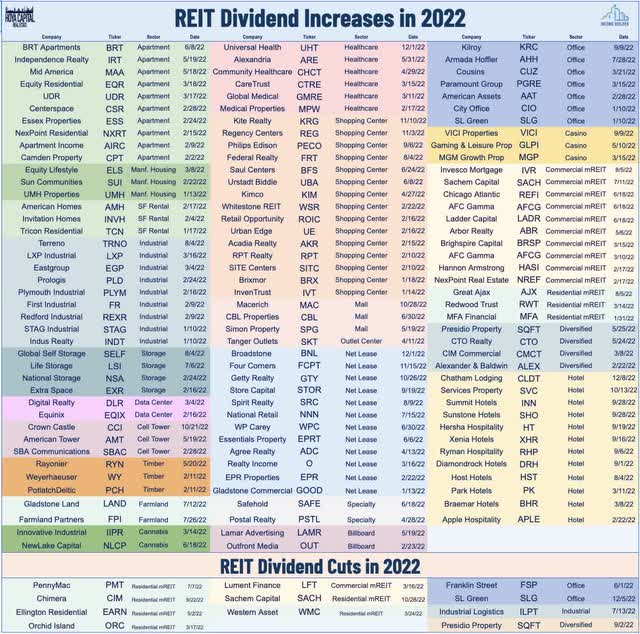
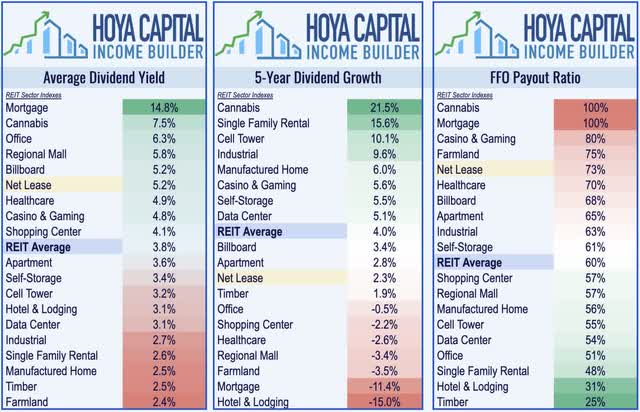
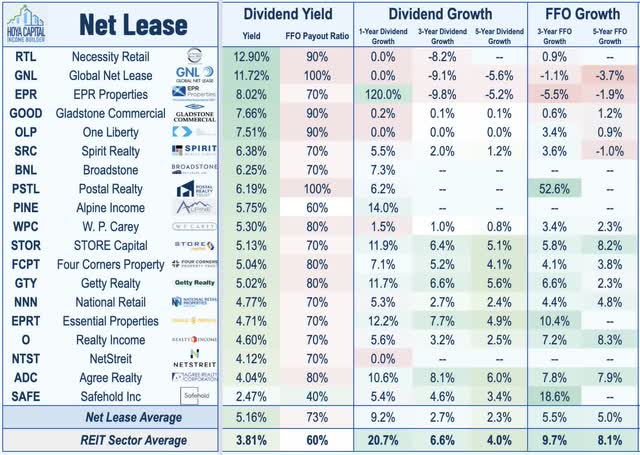
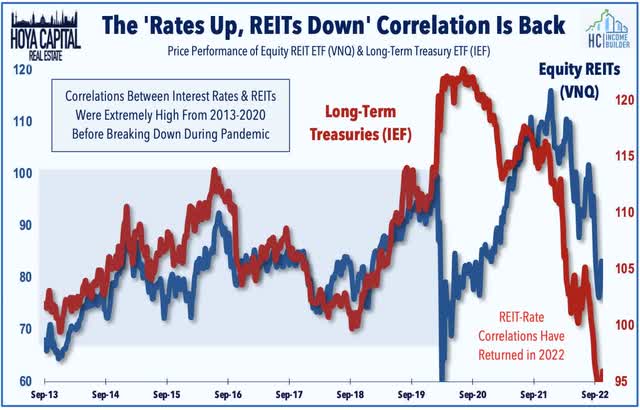
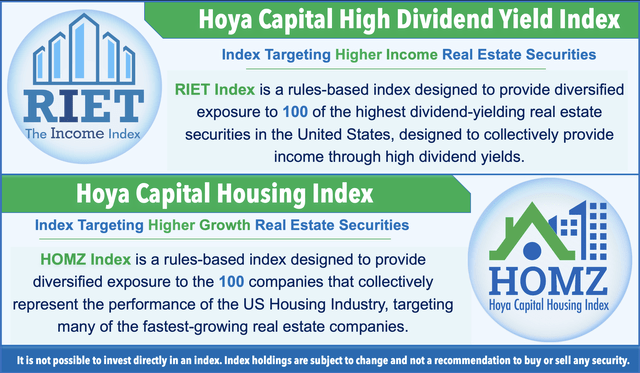
Be the first to comment